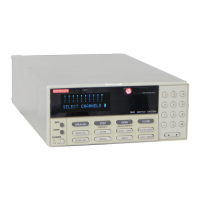IEEE-488 Reference
5-113
5.16.6
:STATus Subsystem
:QUEue commands
[:NEXT]?
:STATus:QUEue[:NEXT]? Query Error Queue
:stat:que?
Power-Up Clears Error Queue
*CLS Clears Error Queue
:STATus:PRESet No effect
As error and status messages occur, they are placed into the Error Queue. This query command
is used to read those messages.
The Error Queue is a first-in, first-out (FIFO) register. Every time you query the queue, the “old-
est” message is read and that message is then removed from the queue. The queue will hold up
to 10 messages. If the queue becomes full, the message “350, ‘Queue Overflow’” will occupy
the last memory location in the register. On power-up, the Error Queue is empty. When the Error
Queue is empty, the message “0, ‘No error’” is placed in the Error Queue.
The messages in the queue are preceded by a number. Negative (-) numbers are used for SCPI
defined messages, and positive (+) numbers are used for Keithley defined messages. The mes-
sages are listed in Table 4-1.
After this command is sent and the Model 7001 is addressed to talk, the “oldest” message in the
queue is sent to the computer.
Note: The :STATus:QUEue[:NEXT]? query command performs the same function as the :SYS-
Tem:ERRor? query command (see System Subsystem).
The following program will read the “oldest” message in the Error Queue:
5 DIM A$ [30]
10 OUTPUT 707; “:stat:que?”
20 ENTER 707; A$
30 PRINT A$
40 END
Line 5 Increase string size to accommodate the length of the messages.
Line 10 Requests the “oldest” message in the queue.
Line 20 Addresses the Model 7001 to talk.
Line 30 Displays the message on the CRT.
Short-form
format
Defaults
Description
Programming
example
Artisan Scientific - Quality Instrumentation ... Guaranteed | (888) 88-SOURCE | www.artisan-scientific.com

